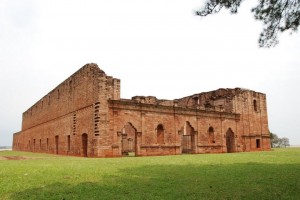 Located about seven miles from the Jesuit ruins in Trinidad, lies the Jesus mission. The Jesuitica de Jesus de Tavarangue, was established in 1685 and was populated with natives from another mission in Paraguay. Construction on the massive stone church began in the 1750’s, but the church was never completed.
Located about seven miles from the Jesuit ruins in Trinidad, lies the Jesus mission. The Jesuitica de Jesus de Tavarangue, was established in 1685 and was populated with natives from another mission in Paraguay. Construction on the massive stone church began in the 1750’s, but the church was never completed.
When the Jesuit’s were expelled from Paraguay in 1767, the church was still many years away from being finished. Had it been completed, the Jesus mission would have had one of the largest churches of the missions. The central structure measures almost 230 feet long and almost 80 feet wide.
Around 3,000 Guarani’s worked on the construction of the church that would have been a replica designed after the famous Church of Loyala in Italy. The red brick stones contrasting amid a flat landscape of lush green, emphasizes the grand scale of the church and what an enormous undertaking it’s construction was.
The buildings at the Jesus de Tavarangue mission have some Spanish styled features. There are three massive arched doors that enter the church structure exhibiting the moor Christian influence. And, the stone walls rising high around the structure are really outstanding.
The bell tower still stands at the Jesus mission, reaching 160 feet in the sky. Numerous bells hung in the towers of the Jesuit ruins in Paraguay, generally at least six. The bell towers rang out as many as three times a day summoning the inhabitants to mass. But, they were also used to alert the small city of the approach of slave traders from Brazil.
The lintels in the churches arched doors are adorned with stones that are hand carved into roses. Bands of carved angels encircle the stone walls and a large stone pulpit still stands. Visitors can walk up the stairs and partake in a magnificent view of the surrounding area.
The ruins of the Jesuit missions reflect a large part of the history of Paraguay. The depict a way of life for the native Guarani’s that was enhanced by the arrival of the Jesuit priests. Although, the architecture of the native’s dwellings weren’t elaborate, they were much better than their original homes of mud and grass.
The Guarani’s shared not only in the work inside the missions, they also shared in the products that were created and grown there. They were introduced to the Roman Catholic religion that still dominates the country today. And, they learned skills and trades that have been handed down through the generations.

{ 0 comments… add one now }